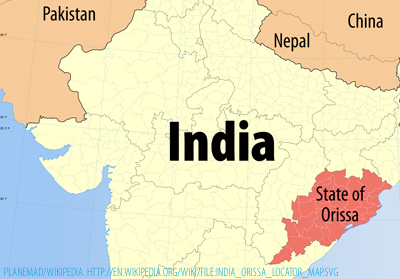
 INDIA—The state of Orissa is a place full of contrasts. It is rich with natural resources and yet home to 40 million of the poorest people in the country. The scenic landscape dramatically changes from 600 miles of coastal plains to lush mountain peaks.
INDIA—The state of Orissa is a place full of contrasts. It is rich with natural resources and yet home to 40 million of the poorest people in the country. The scenic landscape dramatically changes from 600 miles of coastal plains to lush mountain peaks.
However, driving from one town to another requires an all-terrain jeep, spare tires, and extreme patience. The roads are sometimes nothing more than a clearing in the jungle littered with small boulders.
Orissa has a rich culture and is home to 13 ancient tribes. Unfortunately the tribes are fighting for their homeland against large mining corporations seeking minerals inside the mountains.
I came to Orissa in November of 2009 to travel the area, experience the culture, and grow in my faith. My six-month mission experience in India all started with a cup of tea.
Four years ago I attended SpiritualiTea at the Daughters of St. Paul bookstore on King Street in Charleston, S.C. (Click here for related article) It is a Thursday afternoon tea group of College of Charleston students led by Sister Jane Livingston. The group discusses different aspects of spirituality over a cup of tea and biscuits.
Tea was sent to Sister Jane by her friend, Father Mihir Upasi, a priest working in Orissa. Sister Jane would frequently inform our group of the happenings in India. I was always very interested in Father Mihir’s work and life in India, a country about which I knew little.
With the help of Sister Jane and encouragement from Father Mihir, I planned to visit India the summer of 2008. The trip was postponed due to a three-month period of violence and rioting. On Aug. 23, 2008, the Hindu right-wing extremist leader Laxmanananda Saraswati was murdered by unidentified gunmen. He was known for his opposition to the works of Christian missionaries who toiled for the human promotion of the marginalized communities.
Despite condemnations of the murder from Christian leaders, and police theories accusing a different group for the attack, Christians were falsely blamed by Saraswati’s supporters for the leader’s death. Extremist followers destroyed churches and houses belonging to the Christian community and persecuted pastors, priests and religious sisters. The Catholic Church is conducting programs to restore peace, rehabilitate the afflicted and rebuild society.
I graduated from the College of Charleston in May of 2009, worked to save money and purchased my plane ticket to India. I arrived in Jeypore, Orissa, on Nov. 9, 2009, and was greeted by my friend Valerie Soop, another frequenter of SpiritualiTea and a member of the Cathedral of St. John the Baptist. She had been here for a month before me and was thus able to show me the ropes.
For the first week, I stayed at the Precious Pearl Bhavan where Valerie works. It is a home that helps impoverished children obtain a good education in a loving family atmosphere. Valerie spends her afternoons with the seven children, helping them with English and schoolwork, playing games during their free time, and leading them through their first Communion preparation. The group will be growing with the addition of two more boys and a girl in January.
My time is now spent shadowing Father Mihir. We travel Orissa visiting the many different missions of the area. I have also been part of programs by the church for building a more inclusive society. Last week, I attended an interreligious dialogue for peace between Hindus, Muslims, Buddhists and Christians. The religious communities and the relationships between them are being rebuilt; all parties are now working together for peace and harmony in Orissa.
Through my travels I am gaining cultural knowledge, meeting new people and growing in my faith along the way. Spending all my time with Indians has given me a special insight into the lives, traditions and cultures of the people of Orissa. I am documenting my journey by creating a film for the Catholic Diocese in Orissa, and developing a photo book on Orissa: the landscapes, culture, people, religions, food, and fun on the roads.
Orissa is a beautiful state, and the people living here are the ones who give it beauty. It’s a state full of contrasts; though the people are economically poor, they are rich in spirit.
